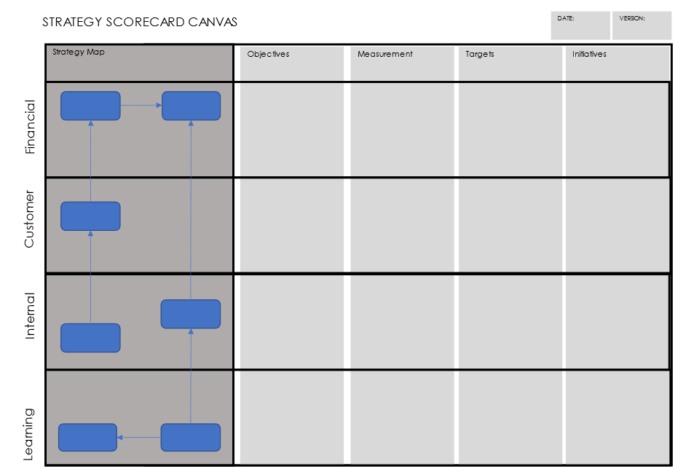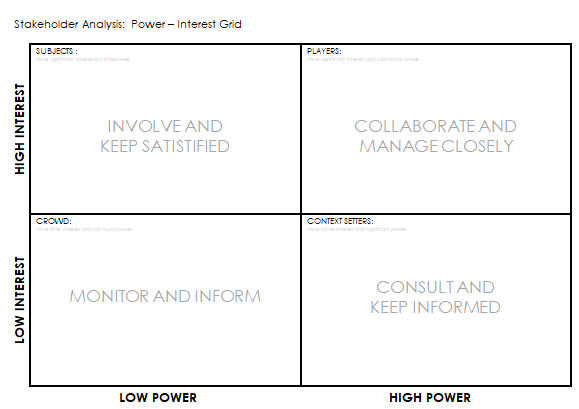
What is strategy
“a detailed plan for achieving success in situations such as war, politics, business, industry, or sport, or the skill of planning for such situations” – definition of Strategy, Cambridge Dictionary
A strategy is a plan for how to achieve success. Strategies can be created for different levels in an organization, for example, corporate (the whole organization), business unit (part of the organizational structure) or capability (specific line of business).
All strategies are different, and depending on the subject of the strategy, will require input from different strategic perspectives. In the book “Fruition” by Chris Potts, the following four perspectives are identified:
- Environmental – external context, legislation, regulation, politics (outside the organization)
- Organizational – organizational structure, culture, internal politics
- Operational – internal processes and operations
- Technical – specifications, products/services and technologies
When working with a strategy it is useful to evaluate which of the perspectives are important, this will help to secure people with the right skills set for working with the strategy.
A key factor of building a strategy is creating objectives and an aim, as well as the tactics required to succeed. In this article the specific focus is placed on creating a Business Technology Strategy.
Why do we need a strategy
Very simply, if there is no plan, there is no direction or coordination. A strategy most importantly provides common aim for all the stakeholders concerned and makes sure they are all pulling in the same direction.
There can be a number of different strategies in play in a single organization, and aligning strategies helps the organization to drive the corporation, business units and capabilities in the same direction, optimizing value. For example, there may be a corporate strategy, business technology strategy and sales strategy in an organization. The business technology strategy and sales strategy may be aligned with the corporate strategy. This alignment allows objectives to cascade from the corporate strategy into the business technology strategy and the sales strategy.
The strategy provides a measurable target by which the organization can measure progress. This is important as it allows corporate management to measure the effect of execution, and for the members of the organization, who gain motivation from a culture of working towards a common goal.
Strategy Approach
Strategy is everybody’s business
In order to effectively execute a strategy, the members in the organization must be committed to the strategy. This means that the strategy must be clearly communicated to the organization to get everyone pulling in the right direction. This can be a delicate exercise if details in the strategy are sensitive, especially if exposed to competitors. Therefore, it is important to plan how strategic objectives are communicated, and different strategies in the organization work together.
Make the scope clear
Before starting work with a strategy be clear on the scope. For example, is the strategy aimed at the whole corporation, the sales department or the IT capability. The scope has an effect on the perspectives required (environmental, technical, operational, organizational) to develop the strategy, which in turn helps to determine the skillsets required from the personnel on the team.
Numbers matter
In order to evaluate the strategy, there is a need to quantify investment and expected value. This means that an important part of the work with strategy is to assess financial viability. While the actual numbers may not be directly visible in the strategy, they are required to support and motivate initiatives and objectives. When the strategy goes to review, this will help to answer the likely questions of “What will it cost?” and “What is the benefit?”.
Strategy is direction over detail
Strategy provides a collective direction for an organization. It aligns an organization, and all it’s working parts so that they travel in the same direction. When working with strategy it is important not to get bogged down in detail. Going into too much detail results in planning operationally rather than providing strategic direction. A strategy with too much detail may be difficult to communicate broadly across an organization, and may be difficult for stakeholders at different levels of the organization to understand.
IT-Architects influence strategy
IT-Architects have a unique perspective within an organization which makes them a valuable influencer when working with strategy. Since IT touches almost all aspects of a business, IT-architects have a view of the organization and the business, which is somewhat unique. For example, IT-architects may support the sales, marketing, logistics, production and financial capabilities of an organization which allows the architect to view the business from many perspectives. This is a rather unique and valuable viewpoint when working with a strategy. In addition, knowledge of technology allows the architect to see opportunities and threats that other stakeholders may miss.
Working with Business Technology Strategy
The Strategic Aim
Every business or organization has an idea or vision of the future. The description of this vision may be rather abstract, but it is extremely important as it provides a common aim. The vision is often expressed as a short textual statement, providing a description of what is to be achieved and why.
For example:
- “Company X is an established provider of flat sheet steel throughout Europe and is a primary supplier to the automobile industry.”
- “The logistics department will provide the company with an exceptional service which can ensure delivery of goods to all customers in the UK within 2 days.”
These statements give an idea of what is to be achieved, but in order for them to be used in practice, it is often not enough with a simple statement. Instead, they need to be refined and expressed in a way that the organization can work with practically, measure progress and ultimately achieve.
It is also important to consider the scope of the strategy in question, the strategy may be the focus of a small or large organizational unit, or it can be for a whole corporation. The objectives of the strategy are defined for the scope and the process to be used for steering the strategy may depend on the scope.
One way to work with strategic objectives is to use a Strategy Scorecard. The strategy scorecard is a combination of the well-known strategy map and balanced scorecard techniques (based on the method from the Balanced Scorecard Institute).
The strategy map provides a way to map out objectives required in order to achieve the strategic aims, and to show the relationships between objectives.
Objectives are placed on the strategy map in four perspectives:
- Financial – provides a view of the financial objectives of the organization
- Customer – provides a view of objectives from a customer perspective
- Internal – provides a view of objectives for the internal processes of the organization including services and products
- Learning and Growth – provides a view of objectives from a human resource, infrastructure or technology perspective
The order of these perspectives is important, learning drives the internal perspective, the internal perspective drives the customer perspective and the customer perspective drives the financial perspective. This is true for most profit-making organizations, but in some cases where profit may not be the focus of the organization (for example non-profit organizations, public sector), the customer may be placed as the top most perspective.
Some examples of objectives in these perspectives are listed below:
Financial: “Increase profit margin”
Customer: “Increase customer satisfaction”
Internal: “Improve service quality”
Learning and Growth: “Improve automated support tools”
On the strategy map relations are drawn between the different objectives to show cause-and-effect. The arrow between two objectives means that the source objective will provide an effect on the target objective. For example, “Increase customer satisfaction” will have an effect on “Increase profit margin”.
Once the strategy map is complete, the scorecard can be used to list the objectives and define the following:
- Measurement – this describes how the objective will be measured by listing the performance indicators (KPI’s)
- Targets – this describes the target value of the objective for the performance indicator
- Initiatives – a list of projects/programs which may be executed to help reach the objective
The balanced scorecard and OKR’s (Objective Key Results) are strategic tools which share some common concepts. The balanced scorecard method tends to be used for “big picture” strategies, for example at corporate level. The strategy is long-term and objectives are perhaps not as agile as OKR’s. OKR’s on the other hand, provide an agile way of managing objectives with a 90-day perspective. While this works well with objectives at an individual/team level it perhaps lacks the perspectives and the “big picture” provided by the scorecard.
Both methods are valid ways to plan objectives, and which method an organization chooses, may depend on the type of business and the culture of the organization. It is also fully valid for an organization to run both methods, using the scorecard method for corporate strategy and using OKR’s to guide objectives at lower levels in the organization. More information about using OKR’s and alignment with the Balanced Scorecard is provided in the goals element of the IASA Engagement Model.
Tactics
The tactics of the strategy consider how the strategy is to be executed. This describes methods and techniques which can be used to gain advantage and achieve success on the journey towards the objectives. The tactics consider practicalities such as resources, economic factors and risk assessment.
An important part of defining tactics is to consider:
- Drivers – awareness of the external forces which influence the strategy
- Establish principles – provide a stable foundation upon which the strategy is based
- Discover opportunities – increase the chances of success by identifying opportunities
- Identify risks – assess probability and severity, consider mitigation
- Stakeholders and Partners – consider the key partners and stakeholders which are required in order to achieve success
- Refine objectives to initiatives – given the objectives from the target, refine these to a number of strategic initiatives (programs, projects) which help to deliver value
The tactics provide the pre-conditions for planning the execution of the strategy. The following are some tools which can be used to help assess and define tactics.
SWOT Analysis
SWOT analysis is a useful tool for identifying strengths, weaknesses, opportunities and threats, and thus help in defining tactics to ensure success. The strengths and weaknesses refer to the internal factors, for example, a strong ability to deliver globally (strength) or long recruitment process (weakness). Opportunities and threats are external factors, for example, high demand for medical products (opportunity) or highly competitive market (threat). The organization has a greater degree of influence over the internal factors, and seeks to take advantage, or mitigate the external factors.
The SWOT analysis works best as a brainstorming tool with a team in a workshop environment. Before beginning the analysis, it should be clear to all participants what the subject of the analysis is. The objectives from the Strategy Scorecard may be used to form the SWOT subject.
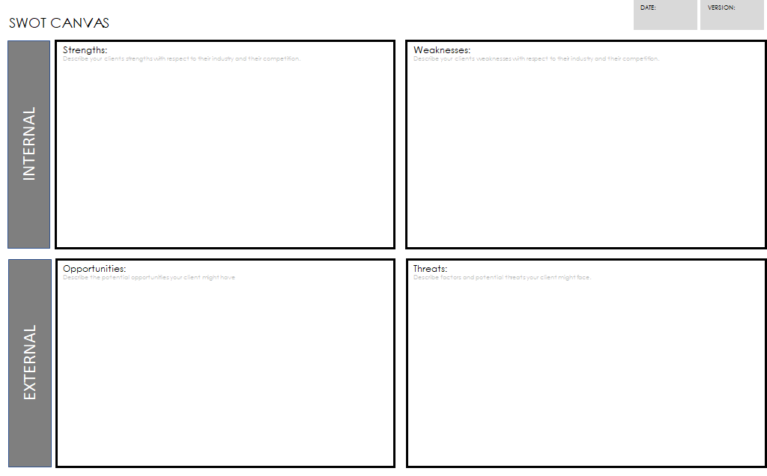
Participants discuss, brainstorm and place the different strengths, weaknesses, opportunities and threats on the canvas.
When the participants have completed their analysis, tactics can be discussed in order to gain advantages from strengths, improve weaknesses, take opportunities and mitigate threats.
PESTEL
A PESTEL analysis considers the surrounding environment of an organization, and the external factors which influence the organization. The analysis considers the environment from five aspects:
- Political – this aspect is concerned with governmental factors which affect the organization. Factors such as government policies, political tendance and certain regulations and laws.
- Economic – this aspect refers to the economic factors which are relevant to the organization. For example, supply and demand of product and services in the relevant market sector, or other financial concerns such as interest rates, tax or inflation.
- Social – this aspect refers to the social environment around the organization. This considers cultural factors, demographics and social well-being.
- Technological – the technological aspect describes technology factors which influence the organization. This includes innovations, technology maturity, trends and disruptors.
- Environmental – this aspect considers environmental concerns such as climate, ethical sustainability, pollution and eco-friendliness.
- Legal – the legal aspect refers to laws and regulations which affect the organization and its products and services. This may include laws or regulations regarding, for example, privacy, health and safety, security, pollution or employment.
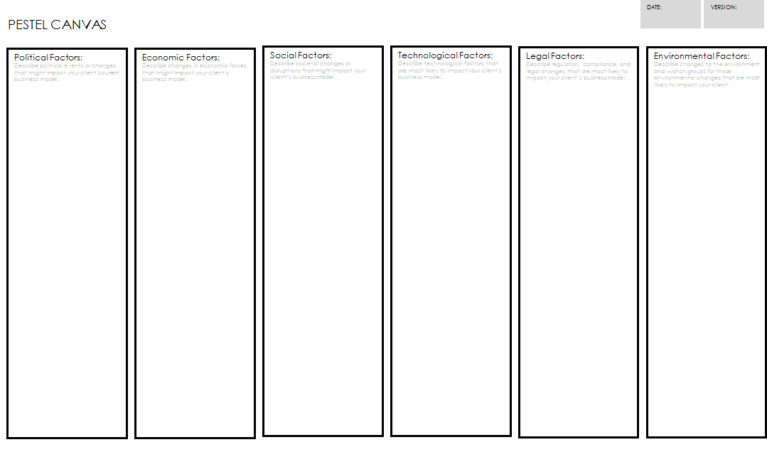
The working method for performing a PESTEL analysis is similar to SWOT. This works best in a team workshop using brainstorming techniques to add factors to each aspect. When the participants feel they have identified all the factors which influence the organization, they can begin to discuss tactics to mitigate threats and take advantage of opportunities. This analysis can be used in combination with SWOT.
ArchiMate Motivation Model
The ArchiMate motivation model provides a way to map the relationships between stakeholders, drivers and assessments (strengths, weaknesses, opportunities, threats). Relations between the assessments can be created to show how they influence each other, positively or negatively. The model can then be used to define goals, outcomes, principles, requirements and constraints.
The motivation model is very much an architect’s tool for analyzing and understanding strategic planning but it is not well suited to stakeholders who are not familiar with ArchiMate.
Risk Matrix
Assessing and managing risks is central to the feasibility and the success of a strategy. The level of risk may determine whether a strategy moves to execution or an alternative strategy is required. The early identification of risks enables mitigation, which can reduce probability and impact.
A risk matrix is a useful way to identify risks and rate them accordingly. Risks are listed in a column, and each risk is given a probability rating, from very unlikely (1) to most likely (5). A rating is also given for the consequences the risk will have if it is realized, from trivial (1) to critical (5).
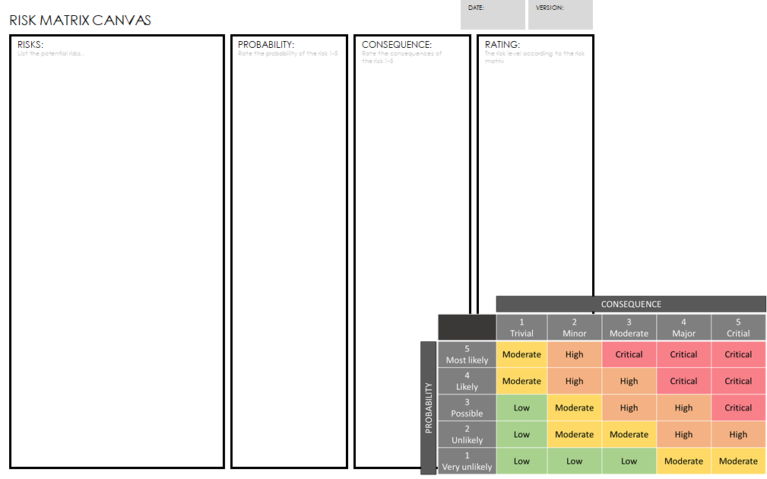
The values for probability and consequence are used together with the risk matrix to provide an overall rating, ranging from low to critical. After rating the risks, an assessment can be made of the strategy and tactics required to best provide mitigation.
Power-Interest Grid
The power-interest grid is a useful tool for identifying tactics based on stakeholders. The grid is used to identify important strategic stakeholders based on the stakeholder interest and power (or influence).
Stakeholders with a high level of interest and power are often central to the success of the strategy, and tactics regarding the management of these stakeholders should be defined. Further information about the power-interest grid and stakeholder management can be found in the stakeholders element.
Planning the execution
The strategic aims and the tactics for the strategy provide the basis for what is to be achieved, and the context for how it is to be achieved. The next step is to provide a plan for the execution of the strategy. Planning the execution of a strategy links to a number of engagement model elements.
Investment planning
Investment planning considers the prioritization of the initiatives identified as part of the work with the Strategy Scorecard, these may be formed as business cases. Investment planning evaluates the costs, benefits, complexity and value delivered from the initiatives and plans the investment to maximize value delivery.
Assignment
Assignment is about planning how the architecture practice evaluates and assigns resources to business cases. This is important in strategic planning, to ensure that the architecture practice has the architect capacity and competencies required to support business case execution. The architecture practice is an active participant in strategic assignment and investment planning, to help ensure the success of the strategy.
Roadmap
Creating a strategic roadmap organizes objectives and initiatives across a timeline. This puts the strategy in perspective for the organization and provides the plan for execution. Without the roadmap it is difficult for an organization to communicate how the strategy will be executed, and to steer the strategy on a time-based perspective.
Customer Journey
An important part of planning a strategy is to understand the customer journey. This will help to plan objectives and tactics by understanding how the customer interacts with the business, it’s products and services. Understanding the customer journey provides an insight into value delivery, this helps in deciding which business cases to prioritize in investment planning.
Track and Adapt
Once a strategy is in play, programs and projects start their execution in order to deliver value, and meet the strategic objectives. As the execution progresses it is important to track the success of the strategy and adapt it as required. This is typically performed as part of a strategic review. Strategic reviews may be conducted in a set time-cycle, or when a major disruption requires that the strategy be reviewed.
Organizations working with OKR’s normally use a quarterly time-cycle (90 days) for strategic reviews, while strategies at corporate level may use longer periods, 6 months or yearly. It is useful to time these reviews so that they coincide with events which provide stable measurements which are used as KPI’s or Key Results. For example, events such as quarterly financial reports or results from customer surveys.
During the review the tactics and risks are assessed, and adjustments made to improve performance as required. If the strategy appears to be failing to meet objectives, it may be the case that the organization abandons the strategy or re-thinks objectives.
References and Further Reading
Strategy Maps
https://balancedscorecard.org/bsc-basics/what-is-a-strategy-map/
Archimate Motivation Model
https://pubs.opengroup.org/architecture/archimate3-doc/chap06.html
SWOT Analysis
https://corporatefinanceinstitute.com/resources/knowledge/strategy/swot-analysis/
PESTEL Analysis
https://www.business-to-you.com/scanning-the-environment-pestel-analysis/

BTABoK 3.0 by IASA is licensed under a Creative Commons Attribution-NonCommercial 4.0 International License. Based on a work at https://btabok.iasaglobal.org/

